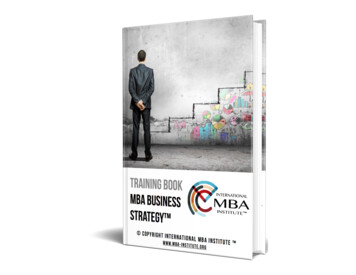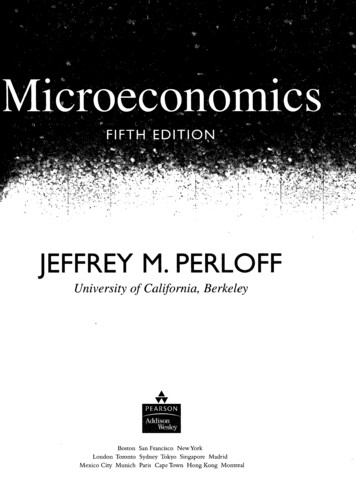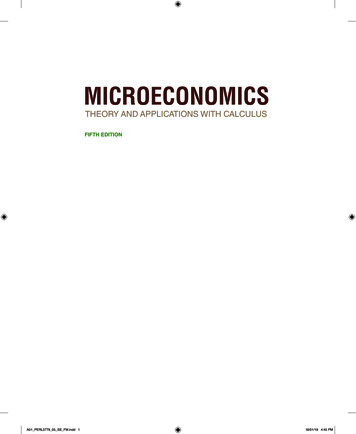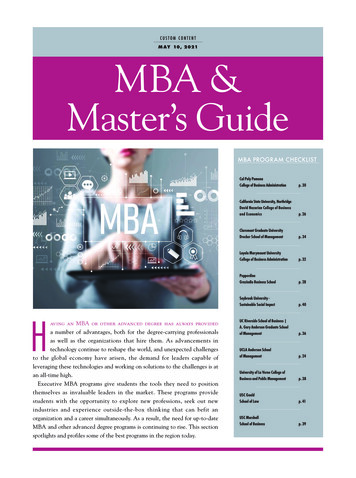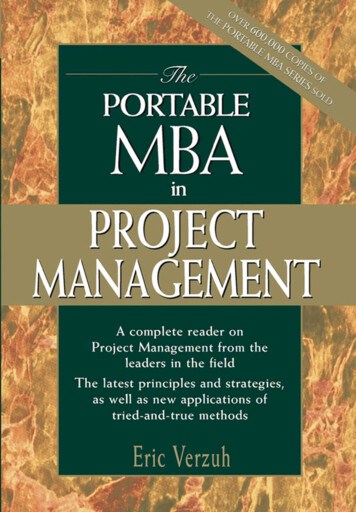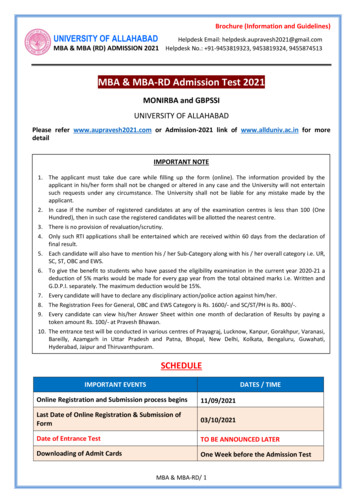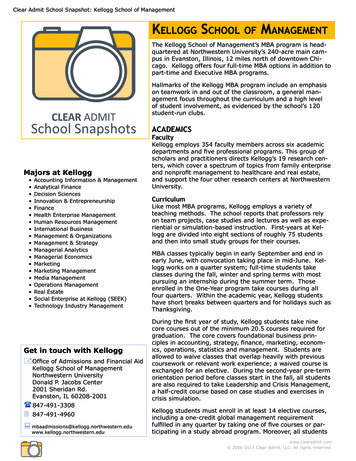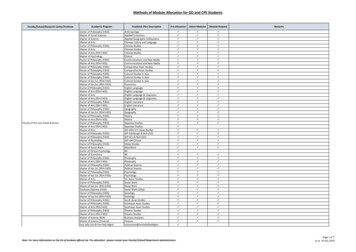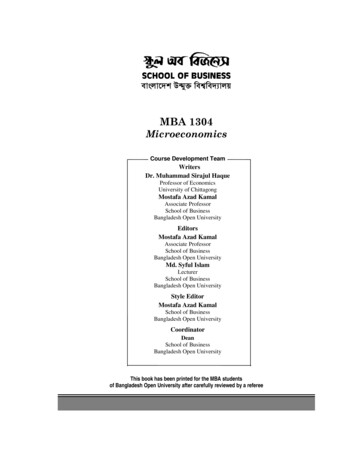
Transcription
SCHOOL OF BUSINESSevsjv‡ k D›gy³ wek we vjqMBA 1304MicroeconomicsCourse Development TeamWritersDr. Muhammad Sirajul HaqueProfessor of EconomicsUniversity of ChittagongMostafa Azad KamalAssociate ProfessorSchool of BusinessBangladesh Open UniversityEditorsMostafa Azad KamalAssociate ProfessorSchool of BusinessBangladesh Open UniversityMd. Syful IslamLecturerSchool of BusinessBangladesh Open UniversityStyle EditorMostafa Azad KamalSchool of BusinessBangladesh Open UniversityCoordinatorDeanSchool of BusinessBangladesh Open UniversityThis book has been printed for the MBA studentsof Bangladesh Open University after carefully reviewed by a referee
MBA 1304MicroeconomicsSCHOOL OF BUSINESSBangladesh Open Universityevsjv‡ k D›gy³ wek we vjq
MBA 1304MicroeconomicsFurther ContributorEditor:Sabiha AfrinLecturerSchool of BusinessBangladesh Open UniversityPublished by: Publication, Printing & Distribution Division (PPD), BangladeshOpen University, Gazipur-1705. School of Business, Bangladesh OpenUniversity, Date of Publication: July, 2008. Computer Compose, DesktopProcessing & Graphics Design: Md. Wahiduzzaman Howlader and Md. AbdulMatin, Cover Design: Monirul Islam, Printed by: Mania Art Press, 53/1, NorthBrook Hall Road, Banglabazar, Dhaka-1100.All rights reserved by the School of Business, Bangladesh Open University.No part of this book can be reproduced or distributed in any form or by any means,or stored in a data base or retrieval system, without prior permission of the publisher
PrefaceThis book is primarily developed for the MBA students of Bangladesh OpenUniversity. It is written in modular form and the lessons have been designed in away so that learners can comprehend the concepts and theories ofMicroeconomics easily by their own.The book has eleven units comprising 30 lessons. We do not claim it to be anoriginal contribution. Rather it should be regarded as a text book of ideas fromvarious renowned authors of Economics/Microeconomics. We have also quotedfrom different text books on Economics usually followed by post-graduatestudents. Our endeavour has been to present the lessons of the book in a verylucid manner so that a distant learner with average caliber can have a completeunderstanding of the concepts and theories of the course within the stipulatedperiod of a semester.Each unit is almost equivalent to one chapter of a conventional text book anddivided into two to four lessons. Each of them starts with "unit highlights". Infact the lessons are like the lecture notes of a classroom teacher, each starts with"lesson objectives" and ends with "review questions". The review questionsinclude essay type questions, multiple choice questions and some real lifeproblems. Also some statements are included in the review questions, from whichthe students will identify the true ones. We hope that self learners will not findmuch difficulty in understanding the lessons by themselves and will not requireany substantial help from the tutor.We have added the real life problems/cases into the book from conventional textbooks Economics/Microeconomics by the renowned writers of western origin.We expect that our MBA students will relate the problems/cases with their ownenvironment and analyse them independently or in group.We are grateful to the honorable Vice Chancellor of BOU, Professor Dr. M.Farid Ahmed, who gave us the most needed support for the current print of thebook. We are also thankful to Professor M. Aminul Islam, former ViceChancellor, BOU, for his inspiration and support in writing the book. The Dean,School of Business, Bangladesh Open University, has made us indebted byextending his sincere cooperation regarding the official formalities concernedwith writing and printing of this book. We also acknowledge with thanks theservices of Md. Syful Islam, Assistant Professor, School of Business, BOU forediting the book. We also thankful to Sabiha Afrin, former Lecturer ofEconomics, School of Business, BOU for her effort during the second print of thebook. Our thanks are also due to Mr. Md. Abdul Matin and MohammedWahiduzzaman Howlader, WPOs of the School of Business, for doing their verybest to complete the task of desktop processing on time.We shall feel rewarded for our labour if both general readers and self-learnersfind this book worthwhile and useful.Dr. Muhammad Sirajul HaqueMostafa Azad Kamal
ContentsPage No.Unit-1: Introduction .Lesson-1: Nature and Methodology of Economics .Lesson-2: The Basic Problems of An Economy .1310 .Unit-2: Demand and SupplyLesson-1: Theory of Demand .Lesson-2: Theory of Supply .Lesson-3: Price Determination: Equilibrium of Demand and Supply.23254254.Unit-3: Elasticities of Demand and SupplyLesson-1: Elasticity of Demand .Lesson-2: Elasticity of Supply .636593Unit-4: Consumer Behaviour. .Lesson-1: Introduction .Lesson-2: The cardinal Utility Approach .Lesson-3: Ordinal Utility Theory Indifference curves .Lesson-4: The Revealed Preference Theory .101103107129154Unit-5: Production, Cost and Supply. .Lesson-1: Concepts Related to Production .Lesson-2: Short run and Long run Cost Curves .Lesson-3: Laws of Returns . .159161173183Unit-6: Perfect Competition .Lesson-1: Characteristics of Perfect Competition, AR & MR Curves inPerfect Competition. .Lesson-2: Equilibrium of a Competitive Firm .Lesson-3: Supply Curve of Firm and Industry.193Unit-7: Monopoly .Lesson-1: Nature of Monopoly Market and AR and MR Curves inMonopoly Market227Lesson-2: Price and Output Determination under Monopoly: Equilibriumof Monopolist. .Lesson-3: Multiplant and Price Discriminating Monopolists .Lesson-4: Monopoly Power, Regulating the Monopoly and the Comparisonbetween Competitive and Monopoly Markets. .225Unit-8 Monopolistic Competition and Oligopoly. .Lesson-1: Monopolistic Competition .Lesson-2: Oligopoly. .Lesson-3: Cartel, Price Signaling and Price Leadership in Oligopoly.259261274284Unit-9: Factor Pricing .Lesson-1: Wage determination in Perfectly Competitive Input Market .Lesson-2: Determination of Wage in Imperfectly Competitive InputMarket. .Lesson-3: Determination of Rent and Interest Rate. .293295195202214234243251306313Unit-10: Welfare Economics . 321Lesson-1: Pareto Optimality and Perfect Competition . 323Lesson-2: Market Failures and the Role of Government . 333Unit-11: Microeconomic Practices in Bangladesh . 345Lesson-1: Microeconomic Practices in Bangladesh . 347
INTRODUCTIONHighlights Nature and Methodology of Economics. Basic Economic Problems of a Society: What to Produce, How to Produce and ForWhom to Produce. Different Economic Systems: Capitalism, Socialism, Mixed Economy. The Government and the Economy.1
School of BusinessBlank this pageUnit-1Page-2
Bangladesh Open UniversityUnit 1Lesson 1: Nature and Methodology of EconomicsObjectivesAfter studying this lesson, you will be able to: State the nature of Economics; Distinguish between inductive and deductive methods; State the format of an economic theory; Distinguish between positive and normative analysis; and Distinguish between Microeconomics and Macroeconomics.Nature of EconomicsEconomics is a social science which deals with economic activities of people.People have unlimited wants, but the resources required to satisfy these wants arelimited. Scarcity of resources in the presence of unlimited wants gives rise to alleconomic activities. If the resources were not scarce, there would not be anyeconomic activity at all. With unlimited resources, a person could get as much ashe would like to have without doing any work. Economics is rightly called thestudy of the allocation of resources for satisfying human wants.Economics isrightly called thestudy of theallocation ofresources forsatisfyinghuman wants.Since people cannot satisfy all wants using limited resources, they have to choosethe most and urgent ones from unlimited wants. A person may feel the wants forfood, color television, and a host of other items, but he must meet his want forfood before anything. The choice problem arises also because a resource hasalternative uses. For example, a piece of land can be used for growing paddy init, or it can be used for building a market on it or it can be put to any other use itsowner thinks most profitable. Once its owner has put it to one use, it cannot beused for other purposes. The best use of a resource can be assured by utilizing itto meet the most urgent and important wants. The definition of Economics isbased on the fundamental concepts of unlimited wants, limited resources, thechoice problem, and alternative uses of resources. Professor L. Robbins refers tothese concepts in his definition of Economics which says, "Economics is thescience which studies human behaviour as a relationship between ends andscarce means which have alternative uses.''The ideas put earlier can be clarified with specific examples. Any human activityrelated directly or indirectly to satisfaction of human wants is called an economicactivity. Economic agents and institutions like households, consumers,production firms, banks, etc., participate in economic activities like production,exchange, consumption, etc. Each economic agent in the economy is presumed tobe an independent decision making unit. Economics formalized the decisionmaking processes of different economic agents under different behavioralassumptions about different economic agents. Suppose, a hungry person hassome money in her/his pocket. She/he can eat her/his lunch or buy a shirt with hismoney. Since he is hungry, he decides to eat lunch. We assume that the personwants to maximize his satisfaction by consuming a bundle of two or morecommodities that she/he can buy with her/his money. Economics sets andMicroeconomicsPage-3Any humanactivity relateddirectly orindirectly tosatisfaction ofhuman wants iscalled aneconomicactivity.
School of Businessexplains the decision-making process of a satiation (utility) maximizingconsumer. In short, Economics provides the guidelines for making the best use ofresources in every sphere of an economic person.Study ofEconomicsteaches a personfive importantthings, cinsights,informationabout economicinstitutions, andeconomic policyoptions.Let's be more specific. In addition to general applicability of economic principlesmentioned earlier, the study of Economics teaches a person five important things,viz., economic reasoning, economic terminology, economic insights, informationabout economic institutions, and economic policy options. First, the study ofEconomics changes the attitude of person towards life. People trained inEconomics analyze everything in terms of costs and benefits. They do somethingif the benefits of doing it exceeds its costs and don't do something if costs exceedbenefits. Second, the study of Economics helps a man appreciate differenteconomic terminologies like GDP, corporations, growth rate, money supply, etc.Third, the students of Economics gain insights about functioning of an economy,exchange rate fluctuations, etc. It is almost a miracle that an economy comprisinghundreds of thousands economic agents with diversified and conflicting interestsfunctions spontaneously and systematically without any chaos and anomaly.Fourth, Economics provides the appreciation about the roles of differenteconomic institutions like corporations, government, and cultural norms in ourlives. Finally, knowledge of Economics enables a person to appreciate theconsequences of government economic policies like a rise in tax rate, a reductionin budget deficit, etc.Methodology of EconomicsEconomicsexperiments withhuman beingwho cannot besubjected to suchcontrolledexperiments.Economics is a science in the sense that it employs scientific methods ofacquiring and disseminating knowledge. There is, however, a sharp distinctionbetween the methods of acquiring knowledge used in Economics and those usedin natural sciences like physics, chemistry, etc. The natural sciences conductcontrolled experiments with inanimate matters and animals in laboratorieswhereas Economics experiments with human being who cannot be subjected tosuch controlled experiments. Moreover, randomness is a latent feature of humanbehaviour. The science of Economics formalized the systematic pattern ofeconomic behavior of a person, if any, not withstanding the wide fluctuations inhis behaviour. Nevertheless, Economics uses scientific methods of acquiringknowledge. Broadly speaking, there are two methods of gathering knowledge,viz., deductive and inductive methods. Our next task is to determine which of thetwo methods is used in Economics.Deductive Versus Inductive MethodsDeductive reasoning starts with general statements. To make inferences forparticular observation in the form of singular statement the following exampleillustrates deductive reasoning :Man is MortalRahim is a man.Rahim is MortalMost of the mathematical theorems are general statements, and working out theexercises following the theorems constitutes application of deductive reasoning.Much of scientific knowledge is, however, based on inductive reasoning.Unit-1Page-4
Bangladesh Open UniversityInductivism requires that knowledge be based on empirical evidence consistingof singular observations. Consider the following example of inductive reasoning :A man named Karim died.Another man named Rahim diedAnother man named Rahman died. Man is mortal.For some times people thought that the inductive method was the appropriatemethod of acquiring scientific knowledge. Newton was thought to have arrived atthe laws of Physics using the inductive methods. But, at the end of the nineteenthcentury, David Hume, a famous philosopher and friend of Adam Smith, observedthat there is a problem in inductive method. No finite quantity of singularobservations could ever prove that any given general statement is true. Suppose,you had the single observation that the sun rose in Dhaka on March 21, 2000. So,what is the proof that it will rise tomorrow? The entire universe might collapse ora major natural disaster might destroy the sun tonight. It is impossible to provethe truth of any knowledge on the basis empirical observations.The economists are aware of the problem of induction and instead of proving theabsolute truth of economic theory (knowledge), they use some acceptablemeasures of truth for evaluating their theories. The economic theories, thoughexpressed in forms of general statements, are based on incomplete induction.They use deductive arguments and the criterion of logical consistency to deriveconclusions for particular observations. The discrepancies between thepredictions of the theories and the real observations are examined, and thesetheories are confirmed or refuted using the conventional measures of truth. Thismethod of acquiring knowledge blending the deductive and inductive methodsand using conventional criteria may be called the conventional method .The Format of Economic TheoryThe preceding paragraphs gave you some general ideas about the methodology ofEconomics. Let's now explain the specific format of an economic theory. Aneconomic theory starts with a set of assertions or postulates, denoted A A1,A2.An , concerning the behaviour of an economic agent. For example, thepostulate may be that consumers maximize utility. The second part of a theoryconsists of a set of testable conditions denoted by C C1, C2, C3.Cn . Thetestable conditions must be observable. For example, if consumers maximizeutility, they must buy a smaller quantity of a normal good when its price goes up.The increased price of the normal good is observable and hence constitutes thetestable conditions of the theory. The third part of the theory comprises a set ofevents, E E1, E2,.En , predicted by the theory. In this example, theprediction is that the consumer will buy a smaller quantity of the normal good.By observing the quantities of normal good bought at different prices, we canexamine whether the prediction of the theory is right. The logical structure ofeconomic theory can be shown by the following arrow diagram:A (C E)It means that if A is true, then C implies E. In this example, if consumersmaximize utility (A), then a rise in the price of a normal good (C) will lead to aMicroeconomicsPage-5The economictheories arebased onincompleteinduction.
School of Businessfall in the quantity of the normal good bought (E). If the prediction is found to becorrect, then the theory is confirmed, not proved. If the prediction is wrong, thenthe theory is refuted. We mentioned earlier that we cannot prove the absolutetruth or falseness of a theory. A useful theory must be refutable but is not refuted.Suppose, we have a theory saying that 'it will or will not rain tomorrow.' Thistheory cannot be refuted anyway and hence is not interesting at all. To beinteresting, all theories must be refutable. An economic theory cannot be provedor disproved. An economic theory is confirmed if the prediction of the theory istrue and refuted if the prediction is wrong.Positive Versus Normative AnalysisNormativeanalysis isconcerned withvalue judgementsabout economicagents.Positive analysis is concerned with the description of economic phenomena asthese are. It analyzes organizations, functions and interactions of economicagents in the economy. It also deals with the nature and consequences of differenteconomic policies. Normative analysis is concerned with value judgements abouteconomic agents. Normative analysis discusses how an economic agent shouldbehave, whereas positive analysis discusses how it behaves. Normative analysissuggests what policy a government should take, whereas positive analysisdiscusses the consequences of different policies. Suppose, for example, thegovernment proposes enacting a law that determines the minimum wage forworkers in ready-made garments industry in Bangladesh. Positive analysis dealswith the following aspects of the minimum wage regulation: What will be the implications of minimum wage for employment level andprice of garments? Who will be the beneficiaries and who will be the losers? What will be the net effect of minimum wage regulation for the economy asa whole? How will the efficiency and equity of the national economy be affected?Normative analysis is concerned with the question of whether the governmentshould implement the minimum wage act at all. It will take a host of economicand non-economic factors into consideration for making value judgments on thisissue.Microeconomicsanalyzes thedecision-makingprocesses ofdifferenteconomic agentsunder differentbehavioralassumptions.It should be noted that much of economic analysis are positive. A few topics inEconomics, however, are normative in nature. Finally, we can think of anothertype of economic analysis, known as the art of Economics. It discusses themethods of applying the knowledge obtained in Positive Economics to achievethe goals determined in Normative Economics. Suppose, we have decided toachieve a particular type of distribution of income in the economy. Given theway the economy works, how can we obtain the specified pattern of distributionof income ? The art of Economics provides answers to this type of questions.Microeconomics Versus MacroeconomicsMicroeconomics deals with behavioral patterns of the smallest economic agentswhich make their decisions independently. It shows how allocation of resources,production of commodities, determination of price, etc., are affected by theindependent decisions of the consumers, producers and other economic agents.Microeconomics analyzes the decision-making process of different economicUnit-1Page-6
Bangladesh Open Universityagents under different behavioral assumptions. For example, it deals with utilitymaximizing behavior of a consumer, profit maximizing behavior of a competitivefirm, revenue-maximizing behavior of an oligopolist, etc. Consumer, households,production firms, markets for products, markets for inputs are a few examples ofmicroeconomic topics. Not only microeconomics discusses the behavior of thesmallest independent decision units, but also discusses the interactions emergingamong different economic agents.Macroeconomics deals with aggregate variables facing an economy. Grossnational product (GNP), aggregate employment level, the general price level, thegrowth rate of the economy, etc., are few examples of macroeconomic topics.The macroeconomic topics are quite distinct from the microeconomic topics. Forexample, Macroecnomics shows how the equilibrium levels of income andconsumption of the economy are determined, whereas Microeconomicsdetermines the utility maximizing levels of commodities of a consumer.Microeconomics discusses the determination of relative prices of the comoditiesand services and Macroeconomics discusses the determination of general pricelevel in the economy.Macroeconomicsdeals withaggregatevariables facingan economy.The assumptions of the two branches of Economics are, of course, different.Microeconomics assumes prices of other commodities and services to remainfixed when it explains the determination of price of one commodity.Macroeconomics, on the other hand, assumes that the relative prices have alreadybeen determined when it explains the determination of the general price level. Insome cases, the boundaries of Microeconomics and Macroeconomics areoverlapping. For example, one topic of Microeconomics is general equilibriumanalysis which shows the simultaneous equilibrium of all consumers andproduction firms in the economy. On the other hand, Macroeconomics analyzesseparately the determinants and functioning of bond market, labor market, etc.Finally, we should note that the values of Macroeconomic variables are not equalto sums of values of microeconomic variables. The study of Macroeconomicswill not be necessary and interesting if macroeconomic variables can be createdby adding microeconomic variables. It can, however, be asserted that the twotypes of variables are quite distinct. Consider, for example, the case of transferpayments to a person, who wins a lottery award of forty lakh taka. There is nodoubt that the income of the person has increased, but national income has notincreased due to the increment in personal income. In other words, nationalincome does not reflect the increment in personal income in this case.MicroeconomicsPage-7The values ofMacroeconomicvariables are notequal to sums ofvalues ofmicroeconomicvariables.
School of BusinessReview Questions Essay-type Questions1.What is Economics? Is Economics a normative or positive science?Illustrate your answer.2.Distinguish Microeconomics from Macroeconomics. What are the uses andlimitations of Microeconomic theories?3.How are economic theories formulated? What are their uses andlimitations? True or FalseWhich of the following statements are true?(a) An economic system is a social organism.(b) An economy is a coordinated system of production, consumption anddistribution activities.(c) An economic system works through such institutions as houesholds,farms, firms, factories, banks, schools, hospitals, government etc.(d) Price mechanism is a process through which prices are automaticallydetermined.(e) Economics is rightly called the study of the allocation of resources forsatisfying human wants.(f)Deductive reasoning starts with general statements.(g) Macroeconomics discusses the determination of general price level inthe economy.(h) Normative analysis is concerned with value judgements abouteconomic agents. Multiple Choice Questions1.The problem of choice between the various uses of resources arisesbecause:(a) resources are scarce(b) resources have alternative uses(c) resources are scarce and have alternative uses(d) alternative uses have different productivity(e) productivity of scarce resources varies in their alternative use andproducers want to maximise their gains.Unit-1Page-8
Bangladesh Open University2.Microeconomics is the study of decision making behaviour of:(a) a group of individuals(b) an individual or a household(c) society as a whole(d) none of the above3.Economics is:(a) a positive science(b) a normative science(c) both a positive and a normative science(d) neither a positive nor a normative science(e) not a science4.An economic theory is a statement of:(a) economic facts(b) economic tendencies(c) realities of economic life(d) none of the above5.The validity of an economic theory is judged by its power:(a) to explain an economic phenomenon(b) to predict the course of an economic phenomenon(c) to prove or disprove a hypothesis(d) to reveal the economic laws6.Economic theory is like a movie or stage play because:(a) it draws attention to the important information bearing on making adecision or solving a problem(b) it provides entertainment for both students and teachers(c) it is a mystery to most people(d) it has little economic value to society7.Which of the following is not Macroeconomic variable:(a) gross domestic product(b) price level(c) level of employment(d) profit of a firmMicroeconomicsPage-9
School of BusinessLesson 2: The Basic Problems of an EconomyObjectivesAfter studying this lesson, you will be able to: State the basic problems of an economy; Define opportunity cost and derive the production possibility curve; State the solutions of fundamental problems under alternative economicsystems; and State the role of government in Economics.Basic Problems of an EconomyThe problems ofan economicsociety are,symbolicallyexpressed bythree questionwords, viz.,what?, how? andfor whom?The central problems of an economic society is similar to the individual problemsexcept for the fact that the problems now relate to the economy as a whole. Themain problem is the scarcity of resources in the face of unlimited wants. Thescarce resources have, however, alternative uses. The problems of an economicsociety are, symbolically expressed by three question words, viz., what?, how?and for whom? The problem of deciding the level of investment can be added tothe above list. We discuss each of these problems systematically by turns.The problem of Allocation of Resources: What?The term 'what?' refers to the problem of allocating resources to the production ofcommodities and services. It is the problem of determining the commodities andservices which will be produced. Related to this problem is the necessity ofdetermining the quantities of selected commodities and services. Had theresource been not scarce, the necessity of selecting and determining the quantitiesof the commodities and services wouldn't have arisen? The concepts ofopportunity cost and production possibility curve can be employed to explain theproblem expressed by the word, 'what?'Opportunity Cost and Production Possibility CurveOpportunity costof undertaking anactivity is theforgone benefitfrom the nextbest activity.Since the concept of opportunity cost is crucial in Economics. We intend topresent a detailed analysis of the concept. Opportunity cost of undertaking anactivity is the forgone benefit from the next-best activity. Though a resource hasalternative uses, it cannot be put into more than one use at the same time. If theowner of a price of land decides to build a house on it, the opportunity cost of thehouse will be the forgone benefit from its next-best use which is, say, growingpaddy in it. The opportunity cost of reading this Economics text-book is the losttime that could be spent reading the Accounting text book.The idea of opportunity cost can be explained with the help of an opportunitycost curve, alternatively known as production possibility curve. Suppose, ahypothetical economy can produce only two commodities, guns and paddy, byusing all its resources. The production possibilities of the economy is shown inFigure-1.1. We measure the quantity of food in million metric tons along thevertical axis and the number of guns in millions along the horizontal axis.Initially, the economy is at point A producing OA quantity of food and no guns.Unit-1Page-10
Bangladesh Open UniversityPerhaps both the people and the government of the economy express theirdissatisfaction in having no guns and would like to produce FC guns bysacrificing AF quantity of food. In other words, the opportunity cost of FC gunsis AF quantity of food. Some resources previously used in producing food werereleased and shifted to the production of guns. Consequently, the production offood fell when the economy stand to produce a small number of guns.FoodACFDGHE0BGunsFigure 1.1 : Production Possibility CurveSuppose the new military ruler of the country w
Microeconomics easily by their own. The book has eleven units comprising 30 lessons. We do not claim it to be an original contribution. Rather it should be regarded as a text book of ideas from various renowned authors of Economics/Microeconomics. We have also quoted from different text books

